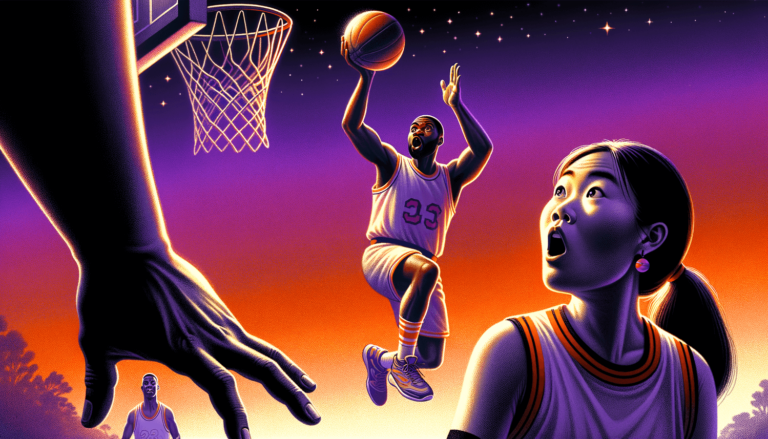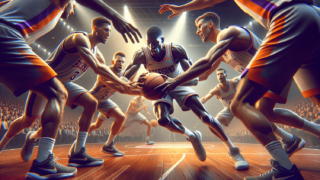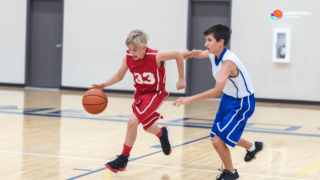
Ever wondered about the gritty aspects of basketball that make great players truly stand out? One of those game-changer techniques comes in the form of the unsung hero – the “Putback.” While putbacks might not make the most stunning highlights or headlines, they are intimately tied to a team’s success. In this blog post, we’ll delve deep into the fascinating world of putbacks, illustrating their significance within basketball. So grab your sneakers, charge up your energy levels, and let’s unlock valuable insights on how this power move can elevate a player’s game!
What’s a Putback in Basketball?
A putback in basketball is a quick, offensive play where a player grabs an offensive rebound and immediately attempts to score a field goal or dunk before touching the ground. Typically, putbacks occur after a teammate’s missed shot, providing the team an opportunity to score crucial additional points while retaining possession of the ball.
Mastering the Art of Putbacks
The putback, despite not being the flashiest basketball play, is a testament to a player’s skill, athleticism, and awareness. In this body of work, we will be exploring various aspects of putbacks, including techniques, benefits, and tips to excel at this crucial craft. Let’s dive in and dissect the ins and outs of putbacks in basketball.
The Importance of Putbacks
Putbacks play a pivotal role in successful basketball gameplay. Here, we outline some key reasons why putbacks are essential:
Extra Scoring Opportunities
Putbacks create additional scoring opportunities after missed shots. An offensive player who successfully executes a putback adds points for their team that would have otherwise been lost. Capitalizing on second-chance points can often be the determining factor in tight games.
Staying in Control
By grabbing an offensive rebound and performing a putback, a player is not only securing points but retaining possession of the ball. This continuous attack on the opponent’s defense can be demoralizing, allowing one team to assert their dominance over the other.
Boosting Team Morale
An unexpected putback can significantly bolster team morale – especially if it comes from a player not typically known for their rebounding prowess. A well-timed putback can shift momentum in a basketball game, energizing the entire team and its fans.
Essential Skills for Putback Success
While putbacks may seem relatively simple, they require a unique mix of skills and an aptitude for recognizing opportunities. Here are some key aspects to consider:
Rebounding Skills
A player needs exceptional rebounding skills to succeed in putbacks. The ability to read the ball’s trajectory, excel at boxing out opponents, and jumping for position will significantly improve one’s chances of grabbing an offensive rebound.
Explosiveness and Agility
Executing a putback demands quick reflexes, explosive leaps, and the ability to remain agile on the court. Great putback artists are often strong athletes who use their power and speed to dominate the paint and surprise their opponents.
Soft Touch and Shooting Ability
Once a player has secured the offensive rebound, they must still convert it into points. Excellent putback specialists possess a soft touch and effective shooting ability to consistently score from close range.
Anticipation and Basketball IQ
Recognizing when a rebound opportunity is about to present itself is a vital skill. A player with a high basketball IQ will be able to anticipate the flight of the ball, as well as gauge their opponent’s offensive intent, positioning themselves well to secure offensive rebounds and execute putbacks.
Putback Techniques
There are various techniques that basketball players can adopt to improve their putback skills. These methods include:
Tip-ins and Tap-ins
Tip-ins and tap-ins are, in their simplest form, a putback attempt with a single hand, using the fingertips to either redirect or tap the ball into the hoop. This method requires impeccable timing and body control, along with an understanding of the ball’s trajectory. A successful tip-in or tap-in is often quick and unexpected, leaving the opponent’s defense stunned.
Putback Dunks
Putback dunks, while not as common as tip-ins or tap-ins, are an electrifying and demoralizing play for the opposing team. After securing an offensive rebound, a player with exceptional jumping ability attempts to slam the ball into the hoop with one or two hands. This explosive move energizes the team and showcases the player’s physical prowess.
Two-handed Putbacks
Two-handed putbacks involve both hands to control and redirect the ball into the basket. This style often provides a better grip and more control over the ball, increasing the chances of a successful putback attempt. Although the motion is not as swift as a one-handed putback, it helps ensure maximum stability and accuracy.
Best Practices for Improving Putbacks
Achieving a high level of skill in putbacks requires diligent practice and smart strategies. Here are some tips and exercises players can incorporate into their practice routines:
Study Offensive Rebound Positions
Identify and comprehend the likely landing zones for offensive rebounds. Players should be familiar with the various angles of shots and anticipate which locations are the most probable for a missed shot to land in, allowing for the quickest reaction and best opportunities for putbacks.
Boxing Out Drills
Improving boxing out skills plays a crucial role in enhancing one’s putback abilities. Drills like the Mikan Drill or Reverse Mikan Drill are immensely helpful in building muscle memory and honing rebounding skills to make putbacks more effective.
Jumping Exercises
Improving an athlete’s vertical leap can have a significant impact on their ability to execute putbacks. Plyometric exercises like box jumps, depth jumps, and squat jumps can help players build explosiveness and allow them to leap higher and quicker when securing offensive rebounds.
One-on-One Putback Challenges
One solid way to enhance putback skills is to engage in one-on-one putback challenges with teammates during practice. These matchups help players develop a better understanding of their strengths and weaknesses in real-time and foster a competitive spirit that can sharpen putback execution.
Outstanding Putback Performers in Basketball History
Throughout basketball history, there have been several players known for their excellent putback skills. Honing their craft over time, these athletes have set the standard for others to aspire towards:
Moses Malone
As the NBA leader for most career offensive rebounds, Hall of Famer Moses Malone was legendary for his ability to outwork opponents under the rim. Malone’s superb putback skills allowed him to collect numerous second-chance points and helped him become a three-time MVP.
Dennis Rodman
Dennis Rodman, affectionately known as “The Worm” due to his relentless pursuit of the ball, was an extraordinary rebounder who used his putback ability to score points and provide valuable contributions to his team’s offenses.
Zach Randolph
Zach Randolph, also known as “Z-Bo,” was renowned for his grit and determination under the rim. Randolph’s knack for putbacks made him an essential asset, and his blue-collar work ethic endeared him to both critics and fans alike.
The profound impact these players have made on the game of basketball serves as an inspiration for aspiring athletes to refine their skills and excel at putbacks, showcasing their importance within a successful basketball strategy.
The Defensive Response to Putbacks
While focusing on mastering putbacks is essential for offensive players, it is equally important to understand how the defense can counter such moves. Teams must analyze the opposition’s game plan, identify key players known for putbacks, and strategically neutralize them to secure defensive rebounds.
Boxing Out and Fighting for Position
A common defensive strategy in response to putbacks involves the act of boxing out. By establishing a strong, wide stance and preventing offensive rebounders from gaining position, defensive players can effectively limit putback opportunities. Practicing drills focused on boxing out and securing contested rebounds will help enhance a team’s defensive abilities.
Communication and Awareness
Communication is crucial to a well-orchestrated defense. Players must be aware of the location and movements of their teammates and offensive opponents to coordinate effective defensive responses. Verbal cues help teammates prepare for a potential putback, enabling them to shift positions, trap the offensive player or block the putback attempt.
Putbacks in Street Basketball and Pickup Games
Putbacks are not exclusive to professional basketball and can be valuable in street basketball and pickup games. Utilizing the tips and techniques discussed here, players can improve their overall game and make an impact in more casual basketball settings:
Adapting to Smaller Courts and More Compact Play
In street and pickup games, players may find putback opportunities more challenging owing to smaller courts and tighter defensive situations. Adapting to these conditions and adjusting strategies will prove beneficial in successfully executing putbacks.
Capitalizing on Irregular Bounces
Outdoor courts and non-regulation rims can lead to irregular bounces and unpredictable shot angles. Embracing these unique conditions and learning to read the trajectory of the ball will result in increased putback opportunities in casual games.
Sharpening Instincts through Repetition
Repetition is key in any sport, and basketball is no exception. Continually practicing putback techniques, regardless of the court conditions, allows players to develop their muscle memory and hone their instincts, leading to improved performance in all basketball settings.
The Putback’s Influence on Player Development
In conclusion, the putback is an unsung yet critical aspect of basketball. Developing putback skills not only contributes to a player’s offensive skill set but also enhances their overall understanding of the game. By recognizing the importance of putbacks, players can elevate the standard of play, leading to more intense basketball match-ups and a heightened love for the game.
FAQs about Putbacks in Basketball
To help you gain a more comprehensive understanding of putbacks, we’ve compiled a list of frequently asked questions and their answers. These topics cover various aspects of putbacks in basketball, from fundamental concepts to practical application.
1. What is the primary difference between a putback and a regular offensive rebound?
A putback specifically refers to an offensive player grabbing an offensive rebound and immediately attempting to score a field goal or dunk before touching the ground. In contrast, a regular offensive rebound is when a player secures possession but does not immediately attempt a shot, opting instead to pass or set up a new offensive play.
2. How important are putbacks in a basketball game?
Putbacks are critical to a team’s success as they contribute to increased scoring opportunities, momentum shifts, and maintaining possession of the basketball. Successfully executing putbacks can often make the difference in close games by providing a team with valuable second-chance points.
3. Which players are typically responsible for executing putbacks?
Although any player on the court can execute a putback, forwards and centers are traditionally responsible for this action because of their positioning near the rim and their rebounding abilities. However, exceptional guards with strong rebounding and jumping abilities can also take advantage of putback opportunities.
4. How can I improve my putback skills?
To improve your putback skills, focus on practicing offensive rebounding drills, honing your jumping ability and agility, developing a soft touch, and building your basketball IQ to better anticipate ball trajectories and opportunities for putbacks.
5. Why do some players opt for putback dunks instead of regular putbacks?
Putback dunks are not only electrifying and crowd-pleasing, but can also serve as a demoralizing play for the opposing team. Players with exceptional leaping ability and timing may choose to execute a putback dunk as a means of asserting dominance and gaining momentum for their team.
6. How can a defensive player prevent a putback?
To prevent putbacks, defensive players can employ boxing-out techniques, maintain constant communication with their teammates, and employ quick reflexes to secure the defensive rebound before an opponent can capitalize on the opportunity.
7. Can a putback be executed using both hands?
Yes, putbacks can be executed using both hands, allowing for increased control and stability when securing the offensive rebound and redirecting the ball into the basket.
8. What are some famous putback plays in basketball history?
Throughout basketball history, there have been several memorable putback plays that have captivated fans and influenced games. One notable example includes Michael Jordan’s game-winning putback against the Indiana Pacers during Game 6 of the 1998 Eastern Conference Finals. Kelly Oubre Jr.’s putback post against the Brooklyn Nets and Dennis Rodman’s numerous putback highlights are also highly regarded in basketball history.
9. How do putbacks fit into an overall offensive strategy?
Incorporating putbacks into an offensive strategy can lead to increased scoring opportunities and sustained offensive pressure against an opponent. Players who excel at putbacks provide important contributions to their team by ensuring offensive efficiency and second-chance opportunities.
10. Are putback techniques applicable in street basketball and pickup games?
Yes, putback techniques can be valuable in street basketball and pickup games. Adapting to smaller courts, irregular bounces, and working on muscle memory through repetition will enhance your putback execution and overall performance in casual basketball settings.
Featured Posts
- No pillar pages found.





